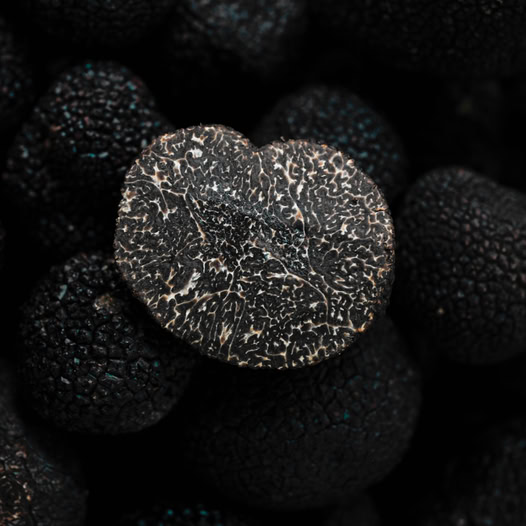The Cultivation of Truffles
Techniques, varieties, life cycle: we tell you everything

Truffle growing, an ancestral art
Truffle cultivation is a traditional craft that highlights exceptional products while preserving local biodiversity.

A unique process
You know the truffle—this prestigious fungus is particularly appreciated by fine gourmets. Its cultivation is unique: it relies on a symbiosis between the fungus and a host tree, most often an oak, which nourishes the truffle through its roots. When planting, we select mycorrhizal trees, meaning their roots have been inoculated with truffle spores. The ideal soils for truffle growing are generally limestone-based, well-drained, and relatively low in organic matter.

Maintenance
Cultivating truffles is a long and delicate process. It often takes four to five years before the first truffles are produced. During this period, maintaining the truffle orchard is essential: the soil must be regularly aerated and weeded. The trees must be pruned, encouraging them to regenerate roots. At La Truffe du Roy, we’ve chosen a mound-based management system with no added water.

Harvesting
Truffle harvesting, known as “cavage,” takes place in winter, from late November to late February. The truffle grower relies on the invaluable help of trained truffle dogs to detect the scent of ripe truffles underground. Truffle cultivation therefore requires not only patience, but also in-depth knowledge of soils and climate conditions to optimize production. In this regard, our estate is committed to sustainable practices, with agriculture that respects the soil and the environment.
Let the truffle tell its story
There are about sixty varieties of truffles in the world. Among them, six are considered gastronomic delicacies.

The Black Truffle of Périgord
The black truffle of Périgord, or Tuber melanosporum, is known for its strong and distinctive aromas. It’s the variety we’ve chosen for our estate in Touraine. Round in shape, it measures a few centimeters in diameter and can weigh from a few grams to 1,000 g. Its color evolves from gray to black and is distinguished by fine white veins when fully ripe. Mainly cultivated in southern and central France, it can also be found in Italy and Spain.
The White Truffle
The white truffle, also known as the Alba truffle or Tuber magnatum pico, is one of the rarest truffle varieties, making it also one of the most expensive. It shares gourmet tables with the black truffle. Its aroma is powerful yet delicate, with notes of fresh garlic or shallot. It is easily recognized by its smooth, off-white skin and flesh that ranges from white to brown, streaked with fine white veins. Harvested from October to January, it grows primarily in the Piedmont region of northern Italy. It cannot be cultivated and must be foraged in the wild.

The Bianchetto Truffle
Similar in many ways to the Alba truffle, the Bianchetto truffle (Tuber borchii or Tuber albidum pico) grows throughout Europe. Small in size, its shades range from yellow to ochre or brown. It is characterized by its intense aroma, with wild notes typical of white truffles. Its harvest season runs from mid-January to late April.
The Burgundy Truffle
Widespread in Europe, the Burgundy truffle (Tuber uncinatum) is able to form symbiotic relationships with many tree species such as pine, hornbeam, oak, or hazelnut. Its aroma, more pronounced than that of the summer truffle, resembles that of the melanosporum, with dominant notes of mushroom and hazelnut. Originally from Burgundy and Alsace, it is also cultivated in southern regions and harvested from September to late January.

The Summer Truffle
The summer truffle (Tuber aestivum) is often confused with the black truffle. However, it differs by its cream-colored flesh with more pronounced, although fewer, white veins. Long overlooked, this truffle is experiencing a revival thanks to its subtle woodland mushroom and hazelnut aromas. Less rare than other varieties, it is also more affordable. Its harvest season runs from April to August.
The Brumale Truffle
Though it closely resembles the black truffle, the brumale truffle (Tuber brumale) stands out with its lighter flesh. Its scent is muskier and less subtle than that of melanosporum, with slightly spicy flavors. No bigger than an egg, it is harvested between November and March.
The Life Cycle of a Truffle
A closer look at the truffle’s development process, from planting to harvest.

Let yourself be tempted by the truffle
Would you like to enjoy a truly unique experience? Dare to adopt two truffle oaks.
- You choose a number and a prestigious alley for your trees.
- You gain access to the Friends of La Truffe du Roy community and all its benefits.
- You receive, as soon as production begins, all the truffles produced by your trees.
